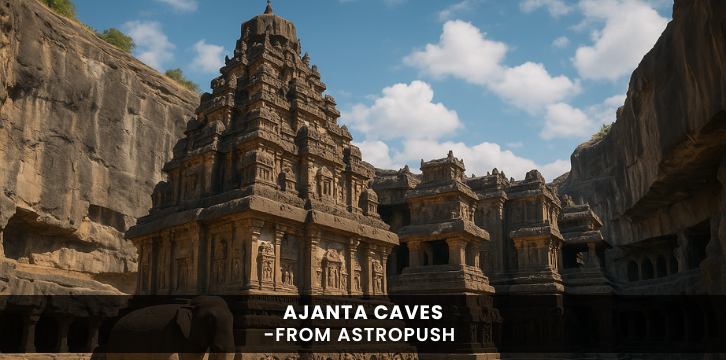When we talk about ancient Indian heritage, the Ajanta Caves always stand out as a shining example of rich history, art, and devotion. Located in Maharashtra, these caves are one of the finest examples of rock-cut Buddhist monuments in India. The Ajanta Caves are not just archaeological wonders, but they also tell beautiful stories through their paintings and sculptures. For anyone interested in history, spirituality, or art, visiting the Ajanta Caves is like stepping back in time.
History and Discovery of Ajanta Caves
Buddhist monks built the Ajanta Caves in two phases. They carved the earliest caves in the 2nd century BCE during the Satavahana dynasty. Later, during the 5th century CE, the Vakataka dynasty supported the creation of more caves. The monks used these caves for meditation, study, and living. They carved them into a horseshoe-shaped cliff along the Waghora River.
For centuries, the caves remained hidden and forgotten by the world. In 1819, a British officer named John Smith accidentally discovered the caves while hunting. Since then, Ajanta has gained global recognition for its artistic and cultural value.
Architectural Brilliance of Ajanta Caves
The Ajanta Caves include 30 caves, each serving a different purpose. Some were built as monasteries (viharas) and some as prayer halls (chaityas). What makes them truly special is that they were carved by hand from the rock using simple tools. This shows the incredible skill and dedication of the artists and craftsmen of that time.
The chaityas, or prayer halls, have beautifully carved pillars and high ceilings with intricate patterns. The viharas, or monasteries, include living quarters for monks and open spaces for learning and discussion. The design and layout of the caves show a perfect blend of practicality and spiritual symbolism.
Art and Paintings in Ajanta Caves
The murals and paintings inside the Ajanta Caves are world-famous. These paintings mainly depict scenes from the life of the Buddha and various Jataka tales, which are moral stories from his previous lives. The use of natural colors, smooth brushwork, and fine detailing make these artworks truly timeless.
Even after centuries, many of these paintings remain clear and vibrant. They reflect not only religious themes but also show daily life, clothing, culture, and emotions of the people of that era. The artists managed to capture the human experience with amazing sensitivity.
Spiritual Significance
Ajanta was more than just a place of art. It was a spiritual center where monks lived, meditated, and taught. The calm and peaceful surroundings of the caves made it ideal for deep reflection. The carvings and paintings were not just decorations; they were part of a sacred space meant to guide the viewer toward spiritual understanding.
In today’s busy life, visiting a place like Ajanta can help people connect with their inner peace. It is a reminder of India’s deep spiritual roots and the importance of mindfulness, compassion, and knowledge.
Also Read – Evil Eye Bracelet: A Symbol of Protection and Good Luck
Ajanta Caves and Modern Recognition
UNESCO recognized the Ajanta Caves as a World Heritage Site in 1983. Tourists, historians, scholars, and artists from around the world visit Ajanta to admire its beauty and explore its history. The Archaeological Survey of India preserves and protects the caves to make sure future generations can also experience their wonder.
The influence of Ajanta’s art can be seen in many parts of Asia, showing how Indian culture and ideas traveled far and wide. These caves also inspire modern artists and designers, proving that ancient wisdom and creativity never go out of style.
Ajanta Caves and Their Influence on Indian Art
The Ajanta Caves shaped early Indian art and architecture in a major way. They inspired many later Buddhist caves and temples, including those in Ellora and South India. Artists at Ajanta combined sculpture, painting, and architecture in one place, which was a new and bold idea for that time. They used creative storytelling and design to express spiritual themes, setting a new standard in religious art.
Role of UNESCO in Preserving Ajanta Caves
Ajanta Caves were declared a UNESCO World Heritage Site in 1983. This status has helped protect the caves from over-tourism and environmental damage. Preservation efforts focus on controlling humidity, limiting visitor numbers, and using soft lighting to protect the delicate paintings. Thanks to these steps, future generations will continue to admire the Ajanta Caves and learn from their stories and craftsmanship.
How to Reach and Best Time to Visit
Ajanta Caves are located near the city of Aurangabad in Maharashtra. The nearest airport is Aurangabad Airport, and it is well connected by road and rail too. From Aurangabad, it takes about two to three hours by road to reach the caves.
The best time to visit Ajanta is between November and March, when the weather is pleasant. During these months, you can explore the caves comfortably without the heat or heavy rains.
Tips for Visitors
- Wear comfortable shoes as you will have to walk and climb a bit.
- Carry water and light snacks.
- Photography is allowed in some areas, but flash is usually not permitted.
- Respect the rules and avoid touching the paintings or carvings.
- Take your time to absorb the details and stories in the artwork.
Also Read – Akshaya Tritiya 2025: A Day of Prosperity, Blessings, and New Beginnings
Connect with Spirituality through AstroPush
If places like Ajanta inspire you to explore your spiritual side, you can do it from the comfort of your home too. With AstroPush, you can chat with astrologer online free, talk to astrologer online free, free kundli, free horoscope prediction, kundli matching, numerology, panchang calendar anytime.
Whether you are curious about your future, looking for relationship guidance, or just want to understand your zodiac signs better, AstroPush is here to guide you. You can contact the best astrologer in India anytime through our easy-to-use application.
Conclusion: Ajanta Caves
The Ajanta Caves are not just old stones or fading paintings. They are living proof of a civilization that valued knowledge, peace, and beauty. In a world that is often too fast and loud, Ajanta stands as a quiet teacher from the past. It tells us that art, faith, and wisdom can live together in harmony.
So whether you are a traveler, a history lover, or someone seeking peace, the Ajanta Caves welcome you with open arms. Let this ancient treasure guide you to a deeper understanding of life, just like the teachings of the Buddha that echo through its walls.
Download the application on PlayStore and AppStore now!





